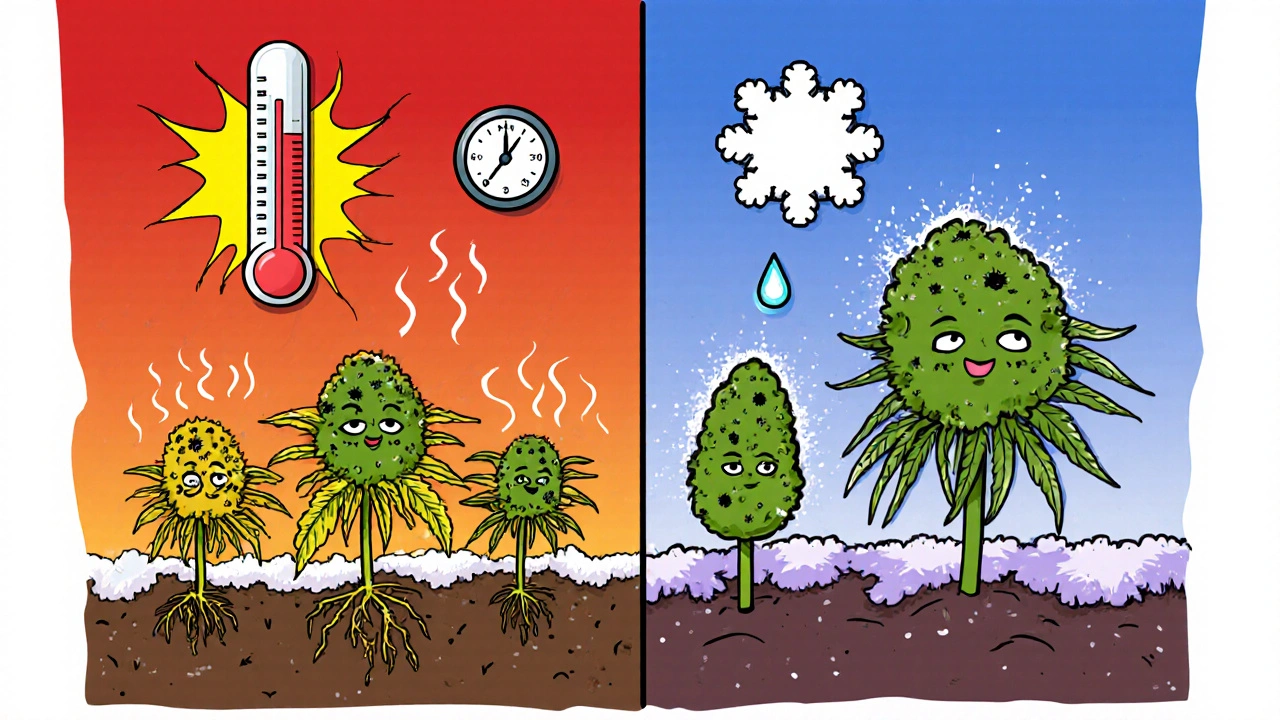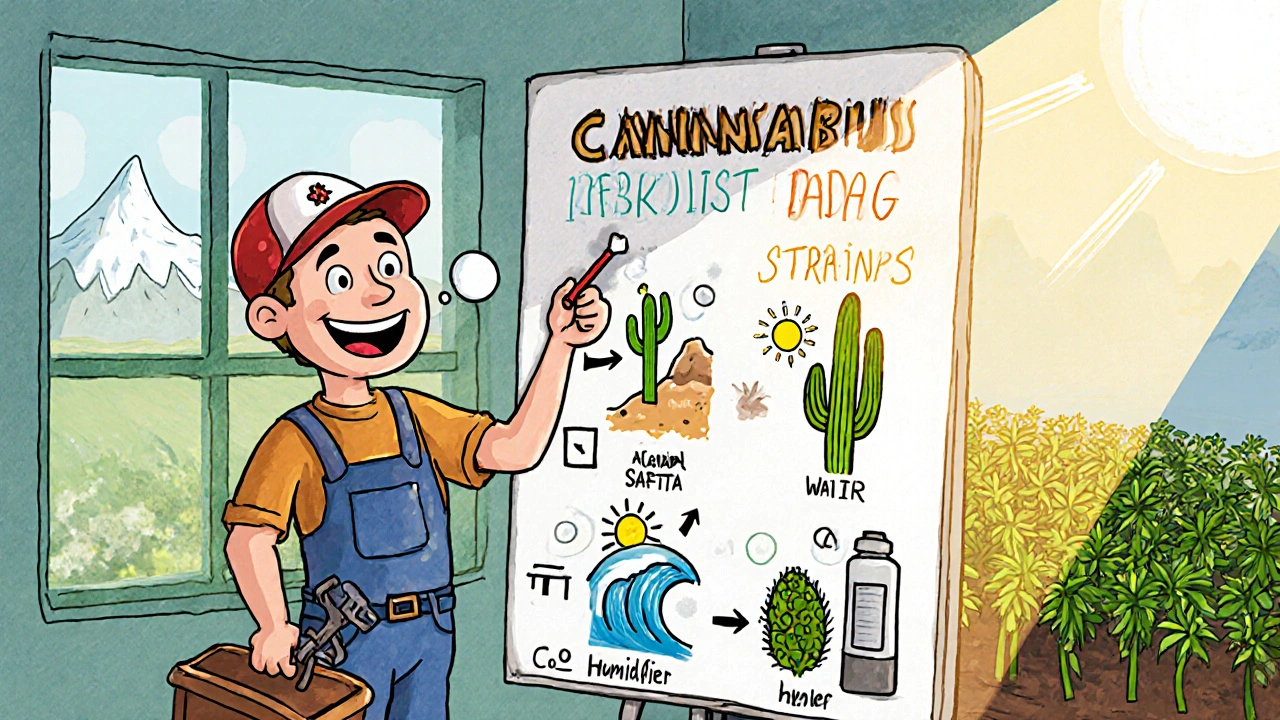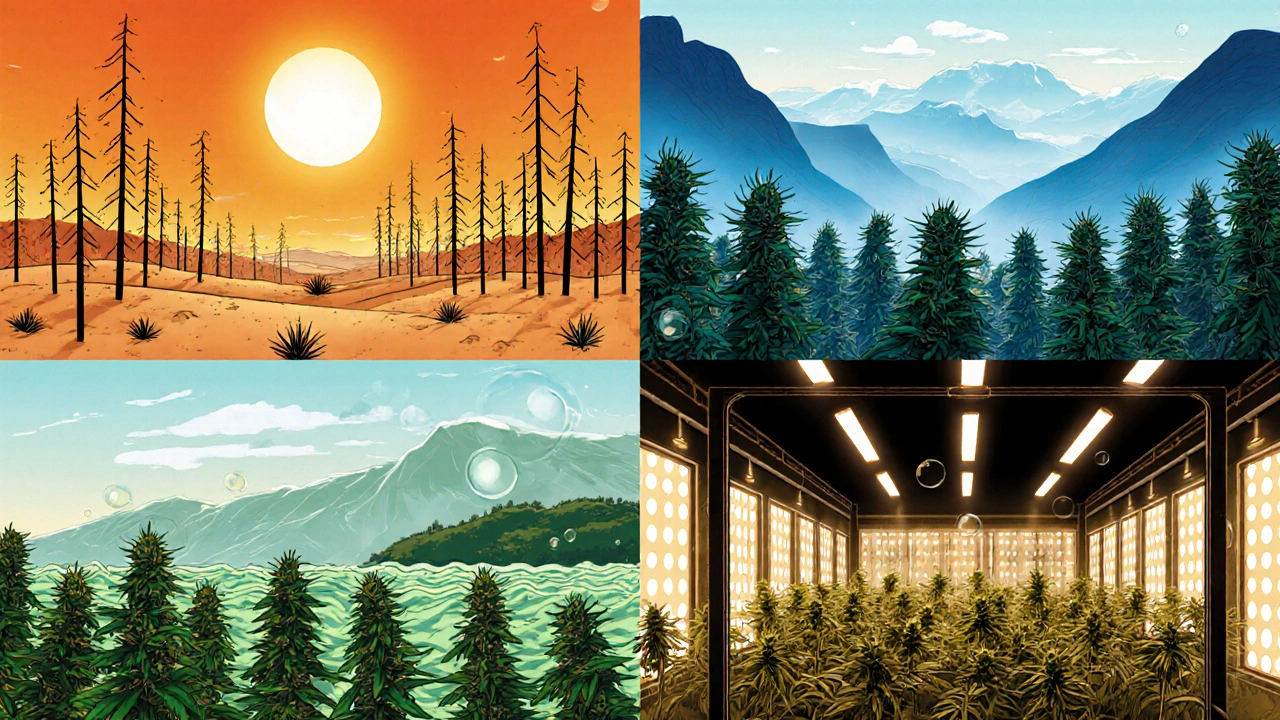Cannabis Temperature Optimizer
Input Parameters
Results
Enter temperature values to see results
Ever wondered why the same cannabis strains can taste so different from one farm to another? The answer lies in the environment they grow in. From sun‑baked deserts to misty highlands, climate and growing conditions rewrite a plant’s chemistry, affecting everything from potency to aroma.
Cannabis strain is a genetically distinct variety of the Cannabis plant, cultivated for its unique mix of cannabinoids, terpenes, and growth characteristics. Understanding how external factors interact with a strain’s genetics helps growers predict yields, lock in desired flavors, and avoid costly mistakes.
Climate Basics: What Growers Need to Know
Climate isn’t just the weather forecast-it's a combination of temperature, humidity, light intensity, and atmospheric pressure that remains relatively stable over a growing season. Each factor pushes the plant’s metabolism in a specific direction.
- Temperature: Influences enzyme activity and photosynthesis rates.
- Humidity: Controls transpiration and disease pressure.
- Light: Drives photosynthetic energy and triggers flowering.
- Altitude & CO2: Affects gas exchange efficiency and resin production.
Temperature: The Goldilocks Zone
Most Growing conditions are judged by how close they stay to the plant’s ideal temperature range-usually 20‑28°C (68‑82°F) for vegetative growth and a slight dip to 18‑24°C (64‑75°F) during flowering. Deviations trigger notable changes:
- Heat stress (>30°C) reduces chlorophyll, leading to pale leaves and slower growth.
- Cold shock (<15°C) can stunt root development and lock the plant in a vegetative state.
- Optimal warmth boosts cannabinoid synthesis, especially THC, which peaks when daytime temperatures hover around 26°C.
Indica‑dominant strains, with their dense bud structure, tend to tolerate cooler nights better than sativa‑leaning hybrids, which prefer steady warmth.
Humidity: Balancing Moisture and Mold
Relative humidity (RH) is a double‑edged sword. During vegetative growth, 50‑70% RH encourages vigorous leaf expansion. As the plant shifts to flowering, lowering RH to 40‑50% reduces the risk of bud rot (Botrytis cinerea) while still allowing trichome development.
High humidity (above 75%) in a tight canopy creates a perfect breeding ground for mold, especially on indica strains with tighter buds. Conversely, overly dry air (below 30%) can stunt terpene production, resulting in a flat aroma profile.

Soil vs. Hydroponics: Medium Matters
Whether you plant in loam, coco, or a nutrient‑film technique, the growing medium shapes root oxygenation, pH stability, and nutrient uptake.
- Soil: Naturally buffers pH, fostering beneficial microbiomes that can enhance terpene complexity.
- Hydroponics: Provides precise control over nutrient solution, often delivering higher THC percentages in as little as 8 weeks, but requires vigilant monitoring of EC (electrical conductivity) and temperature.
- Coco coir: Offers a middle ground-excellent water retention with good aeration, ideal for both sativa and indica hybrids.
Choosing the right medium also depends on climate; in arid regions, soil that retains moisture can reduce irrigation frequency.
Light Quality and Photoperiod: Driving Flowering
Sunlight composition changes with latitude. High‑latitude growers receive more blue light during the long summer days, prompting looser, more airy growth-perfect for sativa genetics. Near the equator, red‑rich light encourages compact, resin‑dense buds typical of indica strains.
Indoor cultivators can mimic these spectra using LED panels that switch between 6500 K (blue) for veg and 2700 K (red) for bloom. Photoperiod-usually 18 hours light for veg and 12 hours for flower-triggers the plant’s internal clock (the circadian rhythm), crucial for consistent cannabinoid ratios.
Altitude and CO₂: The High‑Altitude Edge
Higher altitudes bring thinner air and greater UV exposure. UV‑B stimulates the plant’s protective mechanisms, often boosting THC and certain terpenes (like myrcene) as a natural sunscreen.
Elevated CO₂ levels (1200‑1500 ppm) in sealed grow rooms can increase photosynthetic efficiency by up to 30%, translating into larger yields and higher resin production. However, without adequate ventilation, excess CO₂ can lower pH and cause nutrient lockout.

Tailoring Strains to Your Environment
Armed with climate data, growers can match genetics to conditions:
| Environment | Recommended Strain Type | Key Traits |
|---|---|---|
| Cool, high‑altitude (<15°C night) | Indica‑dominant | Dense buds, high THC, mold‑resistant |
| Warm, humid coastal | Hybrid (balanced) | Moderate terpene profile, sturdy stems |
| Dry desert sun | Sativa‑dominant | Loose canopy, high CBD, UV‑driven THC boost |
| Controlled indoor | Any (choose based on market) | Optimized via lighting and CO₂ |
Practical Checklist for Growers
- Record daily temperature ranges; aim for 20‑28°C veg, 18‑24°C bloom.
- Monitor RH with a hygrometer; adjust ventilators to keep humidity within 50‑70% veg, 40‑50% bloom.
- Test soil pH weekly (target 6.0‑6.8) or hydroponic EC (1.2‑2.0 mS/cm).
- Choose a strain whose genetic background matches your climate profile.
- Use LED spectra that switch from 6500 K (veg) to 2700 K (flower) for indoor setups.
- Consider supplemental CO₂ if you have a sealed grow room; keep levels below 1500 ppm.
- Inspect buds daily for signs of mold, especially in high‑humidity zones.
- Log the final cannabinoid and terpene analysis to refine future selections.
Common Pitfalls and How to Fix Them
Problem: Buds turn yellow and dry out fast.
Cause: Excessive heat or low humidity.
Solution: Raise RH to 55% with a humidifier, and lower daytime temperature to 24°C using shade cloths or ventilation.
Problem: Persistent mold on lower buds.
Cause: Stagnant air and RH above 70% during bloom.
Solution: Increase airflow with oscillating fans, prune lower foliage, and drop RH by 5‑10%.
How does temperature affect THC levels?
Warmer daytime temperatures (around 26°C) stimulate the enzymes that synthesize THC, often increasing final potency by 5‑10% compared to cooler conditions.
Can I grow indica strains in a hot desert?
Indicas prefer cooler nights; in a desert you’d need nighttime shade or evaporative cooling to keep temps below 24°C, otherwise the plants may become stressed and yield lower resin.
What humidity range is safest for flowering?
Aim for 40‑50% RH during flowering; this limits mold risk while still allowing trichomes to develop fully.
Is hydroponic growing always better for potency?
Hydroponics can boost potency because nutrients are precisely delivered, but success still depends on temperature, light, and CO₂ management. Poorly controlled hydroponic systems can underperform compared to well‑managed soil.
How does altitude influence terpene profiles?
Higher altitude exposes plants to more UV‑B radiation, which often triggers the synthesis of protective terpenes like myrcene and limonene, giving the buds a brighter, more aromatic character.

10 Responses
Hey buddy, I get how confusing climate stuff can be, but don’t worry-you’re not alone in this learning curve.
Teh way temperature swings and humidity levels dance together can totally change the terpene profile of a strain.
Stay patient, keep notes, and you’ll see the pattern eventually, I promise.
It is an incontrovertible fact, supported by innumerable peer‑reviewed studies, that the agribusiness conglomerates deliberately manipulate climatic data to conceal the true potential of certain cannabis genotypes.
Such obfuscation serves to maintain market dominance and stifle independent growers who might otherwise capitalize on terroir‑specific advantages.
Therefore, any attempt to discuss strain variability without acknowledging this covert interference is fundamentally flawed.
The interaction between genotype and environment, often colloquially referred to as the "terroir effect," is a multifaceted phenomenon that warrants meticulous examination from both a botanical and a phytochemical perspective.
When a cultivar is exposed to a diurnally fluctuating temperature regime that oscillates between the optimal vegetative range of 20 °C and the cooler, stress‑inducing threshold of 12 °C, the enzymatic pathways governing cannabinoid biosynthesis are modulated in a manner that can amplify the proportion of minor cannabinoids such as CBC and CBG.
Concurrently, relative humidity levels that linger above 80 % during the flowering phase foster a micro‑environment conducive to the proliferation of Botrytis cinerea, which not only compromises yield but also alters the aromatic bouquet through the degradation of volatile terpenes.
Moreover, altitude exerts a pronounced influence on CO₂ diffusion efficiency, thereby affecting photosynthetic capacity and ultimately the resinous gland density on the inflorescences.
In high‑altitude locales, the reduced atmospheric pressure paired with increased ultraviolet exposure often triggers a defensive response in the plant, resulting in a more robust trichome development that is directly correlated with heightened potency.
Nevertheless, it is imperative to recognize that these physiological adaptations do not occur in isolation; they are interdependent with the soil microbiome, which can either synergize with or impede the plant’s metabolic output.
A diverse consortium of mycorrhizal fungi, for example, enhances phosphorus uptake, thereby facilitating the synthesis of ATP‑dependent enzymatic reactions essential for cannabinoid precursor formation.
Conversely, nutrient deficiencies, particularly of nitrogen and potassium, may lead to stunted growth and a concomitant reduction in both yield and cannabinoid concentration.
From a practical cultivation standpoint, implementing controlled environment agriculture-such as precision LED lighting calibrated to mimic the spectral distribution of natural sunlight-enables growers to fine‑tune photoperiods and mitigate the stochasticity inherent in outdoor climates.
Such technological interventions, when coupled with real‑time environmental monitoring systems, empower the cultivator to maintain the plant within its so‑called Goldilocks zone, thereby optimizing both potency and terpene fidelity.
Additionally, the deliberate manipulation of CO₂ enrichment levels, typically targeting a concentration of 1200 ppm during the vegetative stage, can accelerate growth rates while also influencing the biosynthetic flux toward desired cannabinoids.
It is also worth noting that the timing of stress applications-such as controlled water deficit during the late flowering stage-can be employed strategically to provoke a cascade of secondary metabolite production, a practice commonly referred to as "flushing".
However, growers must exercise judicious restraint, as excessive stress may provoke irreversible damage and compromise the overall health of the plant.
In summary, a holistic approach that integrates climatic variables, nutrient management, microbial symbiosis, and cutting‑edge environmental control technologies stands as the most robust methodology for preserving strain integrity and achieving consistent product quality.
By adhering to these principles, cultivators can not only predict yields with greater confidence but also tailor the sensory profile of their harvests to meet the discerning preferences of consumers worldwide.
Yo, if you think you can just ignore the basics of temperature and humidity and still expect a premium bud, you’re living in a fantasy world.
Reality check: most rookie growers skip the science and end up with weak, watery plants that taste like plastic.
Empirical evidence unequivocally demonstrates that the failure to maintain a consistent photoperiod is the single most prevalent cause of hermaphroditic expression in Cannabis spp.
Consequently, any cultivation methodology that neglects this parameter is, at best, negligent and, at worst, detrimental to both yield and cannabinoid consistency.
I feel the weight of every careless grower who tosses away potential
It’s a silent tragedy that echoes in every wilted leaf
We can’t let this story repeat
The data you presented about altitude effects is interesting, but it lacks a discussion on how soil pH interacts with those same factors.
In my experience, a slight shift in pH can either amplify or completely negate the benefits of higher CO₂ levels.
Overall, a more comprehensive analysis would strengthen your argument.
Hey folks, great stuff! Keep experimenting with different light spectrums-you’ll be amazed at how the flavors pop.
Stay positive and enjoy the journey.
It is essential for cultivators to adopt an integrated pest management strategy that synergizes biological controls with cultural practices.
This approach not only safeguards plant health but also upholds the integrity of the final product for diverse consumer bases.
Listen up, team! When the night temps dip below the sweet spot, the plant throws a tantrum and the terps go wild, but that’s where the magic happens!
Embrace the drama, ride the chill, and you’ll harvest a batch that sings with flavor.